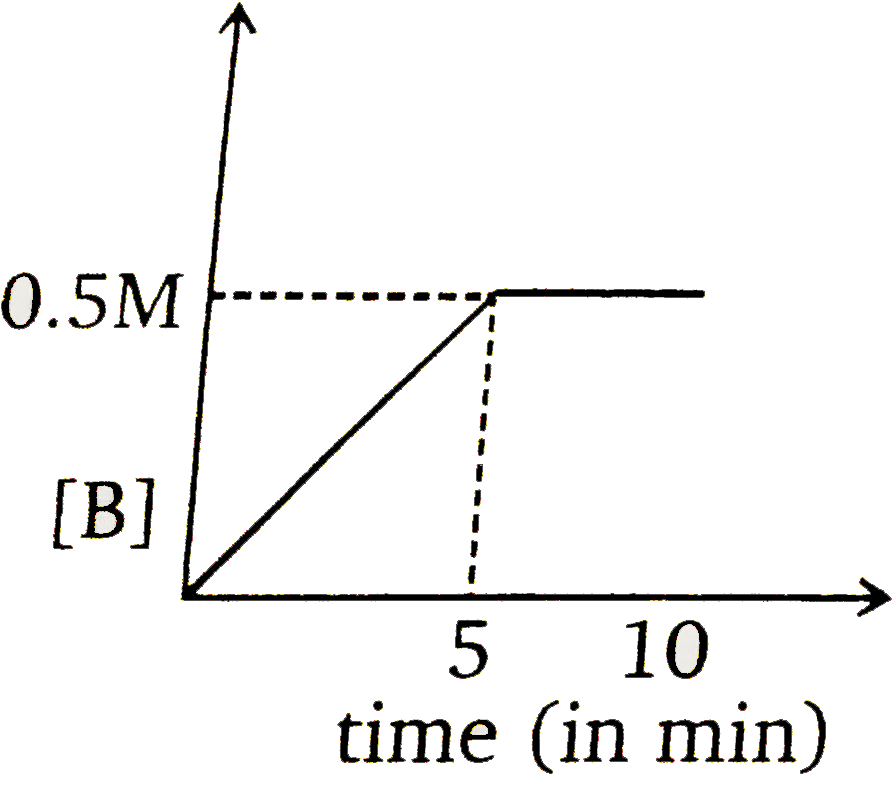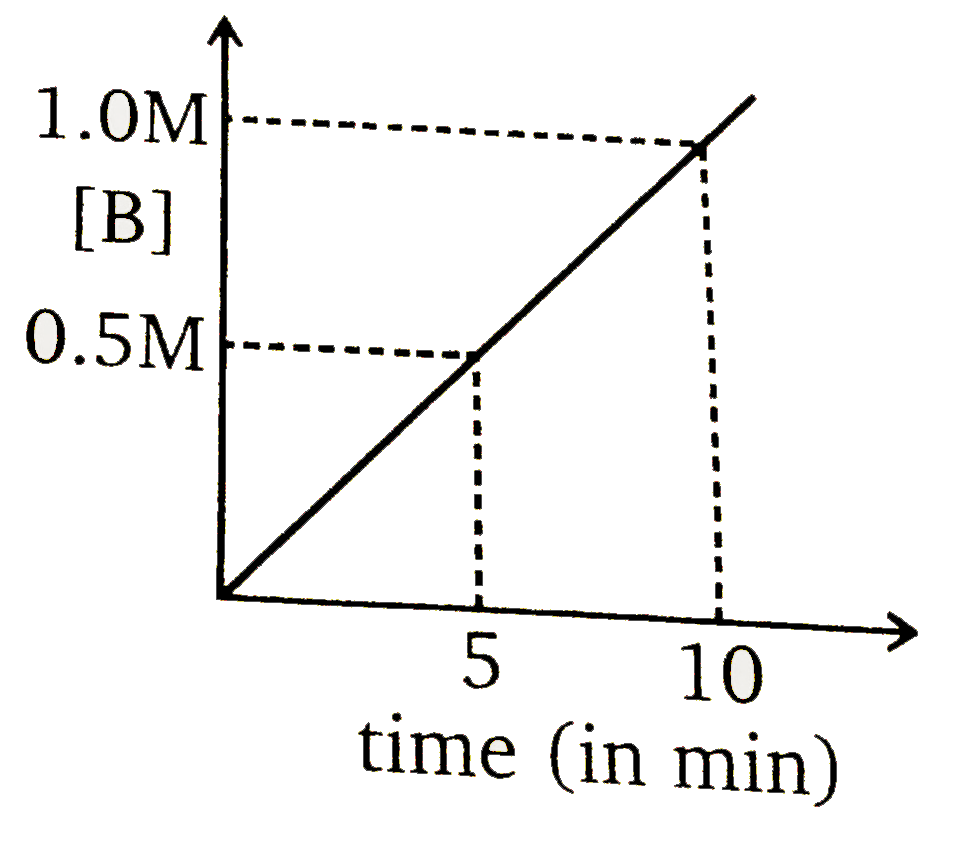Consider a reaction . If initial concentration of A is 0.5 M then select correct graph.
a)  b)
b) 
c)  d)
d)  Solution in Punjabi
Solution in Punjabi




The correct Answer is:C
Step by step video & image solution for Consider a reaction A(g)overset(k=0.1 M min^(-1))to2B(g). If initial concentration of A is 0.5 M then select correct graph. a) b) c) d) by Chemistry experts to help you in doubts & scoring excellent marks in Class 12 exams.
Updated on:21/07/2023Topper's Solved these Questions
- CHEMICAL KINETIC & NUCLEAR CHEMISTRYBOOK - NARENDRA AWASTHICHAPTER - CHEMICAL KINETIC & NUCLEAR CHEMISTRYEXERCISE - Level 1 (Q.3 To Q.32)
1 Videos
- CHEMICAL KINETIC & NUCLEAR CHEMISTRYBOOK - NARENDRA AWASTHICHAPTER - CHEMICAL KINETIC & NUCLEAR CHEMISTRYEXERCISE - Level 1 (Q.33 To Q.62)
2 Videos
- SURFACE CHEMISTRYBOOK - NARENDRA AWASTHICHAPTER - SURFACE CHEMISTRYEXERCISE - Level -2
1 Videos
Similar Questions
The following data pertain to reaction between A and B
S.No[A][B]RatemolL−1molL−1molL−1sec−1I1×10−22×10−22×10−4II2×10−22×10−24×10−4III2×10−24×10−28×10−4
Which of the following interference(s) can be drawn from the above data
(a) Rate constatnt of the reaction 10−4
(b) Rate law of reaction is k[A][B]
(c ) Rate of reaction increases four times on doubling the concentration of both the reactant Select the correct answer codes:
a) a,b and C
b) a and b
c) b and c
d) c alone
View Solutioncolumn Icolumn IIP.Zero order reaction1.t1/2α1[A]0Q.First order reaction2.t100%=[A]0/kR.second order reactions3.Involves at least two reactantsS.Pseudo unimolecular reaction4.[A]=[A]0e−kt
View Solutionfor the graph below, select correct order of temperture ?

View SolutionConsider a reaction A(g)k=0.1M−1min−−−−−−−→2B(g). If initial concentration of A is 0.5 M then select correct graph.
View SolutionThe kinetic date for the given reaction A(g)+2B(g)K−−→C(g) is provided in the following table for three experiments at 300 K Ex. No.[A/M][B/M]Initial rate(Msec−1)1.0.010.016.930×10−62.0.020.011.386×10−53.0.20.021.386×10−5<b>Ina¬herexperiment⋆t∈gswith∈itialconcentrationof0.5and1MrespectivelyforAandBat300K,f∈dtherateofreactionafter50minutesomthe⋆t∈gofedperiment(∈M//sec).
View SolutionFor the reaction, A(g) rarr B(g) +C(g) Select the correct graph.
View SolutionThe rate law expresses the relationship of the rate of a reaction to the rate constant and the concentration of the reactants raised to some powers for the general reaction. aA+bBtocC+dD Rate law takes the form r=k[A]^(x)[B]^(y) where x and y are number that must be determined experimentely k is the rate constant and [A] and [B] are concentration of A & B respectively. The initial rate of zero order reaction of the gaseous equation A(g)to2B (g) is 10^(-2) M min^(-1) If the initial concentration of A is 0.1 M what would be concentration of B after 60 seconds ?
View SolutionA(G)+B(g)⇔C(g)+D(g)
Above equilibrium is established by taking A& B in a closed container. Initial concentration of A is twice of the initial concentration of B. At equilibrium concentraons of B and C are equal. Then find the equilibrium constant for the reaction, C(g)+D(g)⇔A(g)+B(g).
View SolutionThe reaction M 2A(g) + B (g) hArr 3 C (g) + D (g) is begun with the concentrations of A and B both at intial value of 1.00 M. Whenequilibrium is reached , the concentrations of D is measured and is reached , the concentration of D is measured and found to be 0*25 M . The value for the equilibrium constant for this reaction is given by the expresion
View SolutionThe half-life of a first order reaction is 30 min and the initial concentration of the reactant is 0.1 M. If the initial concentration of reactant is doubled, then the half-life of the reaction will be
View SolutionThe half life of a first order reaction is 30 min and the initial concentration of the reactant is 0.1 M . If the initial concentration of reactant is doubled ,then the half life of the reaction will be
View SolutionFor the following reaction :
A(g) +B(g) → 2C(g) + D(g),
the rate law is given as rate of disappearance A=K[A]2/3[B]1/3. If initial concentration of A and B are 2M each and no C and D were present initially, then the time at which total concentration (sum of concentration A, B, C, and D) will become 5.5 M, is :
(Given : K = 1.386×10−1−1min
View SolutionFor a gaseous reaction,
2A(g)+B(g)→C(g),ΔH=−30Kcal/mole at300K
If the reaction follows the rate law d[C]dt=4×10−3[A]2[B]M/min and initially concentration of Bis[B]=10−3M and concentration of A is [A]=1M, then calculate the rate at which heat will be liberated per minute initially if reaction occurs in a rigid container of volume 10 litres.
[Express answer in 10−1cal/min]
[Use:R=2cal/molK]
View SolutionFor the reaction A(g) to 2B(g) (d[B])/(dt) = 6xx10^(-4) M sec^(-1) "when" [A] = 0.1 M (d[B])/(dt) = 2.4xx10^(-3) M sec^(-1) when [A] =0.4 M Find the time taken (in seconds) for concentration of A to change from 0.6 M to 0.15 M.
View SolutionA(g) to B(g) + C(g) Initial concentration of A is 20 M and concentration of C after 18 minutes is 15 M then calculate half life time (in minues) of reaction (Assuming decomposition of A follows first order Kinetics).
View SolutionFor the reaction 3A(g)k−−→B(g)+C(g) k is 10−4L/mol.min.
If [A] = 0.5M then the value of −d[A]dt(in ms−1 is:
View Solution
